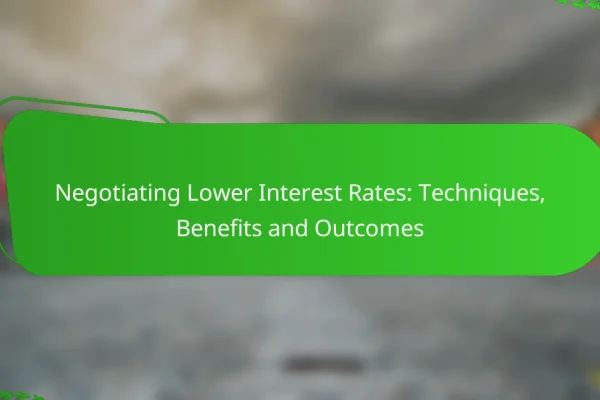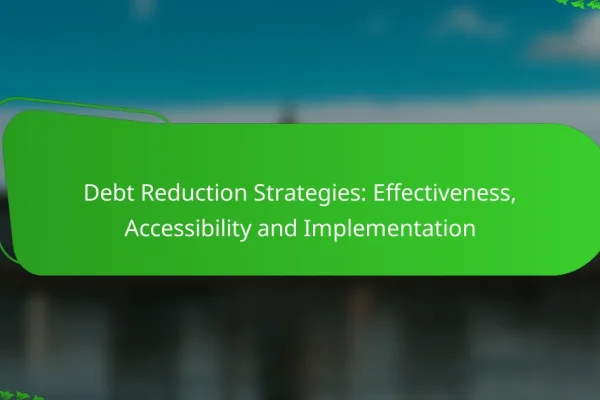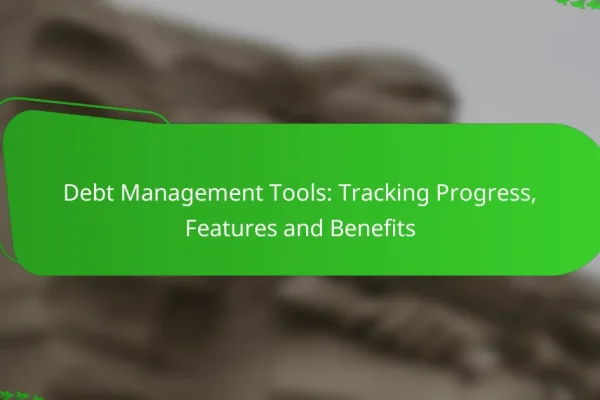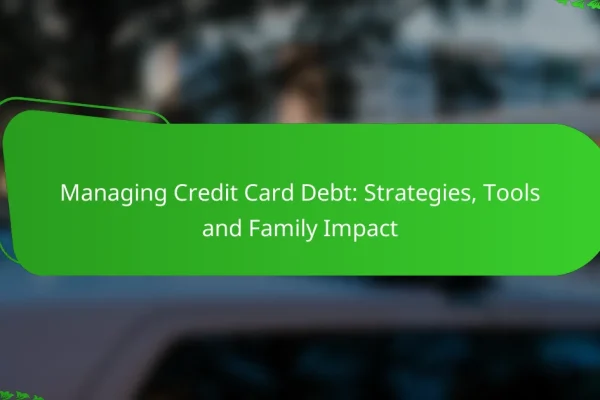What are effective debt management strategies for financial freedom?
Effective debt management strategies help individuals regain control over their finances and work towards financial freedom. Key methods include the debt snowball and avalanche techniques, debt consolidation loans, credit counseling services, and budgeting techniques.
Debt snowball method
The debt snowball method focuses on paying off the smallest debts first while making minimum payments on larger debts. This approach builds momentum as you eliminate debts, providing psychological benefits that encourage continued progress.
To implement this method, list your debts from smallest to largest. Allocate any extra funds to the smallest debt until it is paid off, then move to the next smallest. This can be particularly motivating for those who need quick wins.
Debt avalanche method
The debt avalanche method prioritizes debts with the highest interest rates, minimizing the overall interest paid. This strategy can save money in the long run but may take longer to see progress compared to the snowball method.
Begin by listing your debts from highest to lowest interest rate. Focus on paying off the debt with the highest rate first while making minimum payments on others. This method is ideal for those who are more motivated by financial savings than quick results.
Debt consolidation loans
Debt consolidation loans combine multiple debts into a single loan, often with a lower interest rate. This simplifies payments and can reduce monthly expenses, making it easier to manage debts.
When considering consolidation, compare interest rates and terms from various lenders. Look for loans with no hidden fees and favorable repayment terms. Be cautious of extending the repayment period, which may increase total interest paid.
Credit counseling services
Credit counseling services provide professional advice on managing debt and creating a budget. These services can help individuals develop a personalized plan and may offer access to debt management programs.
Choose a reputable credit counseling agency, preferably one accredited by a recognized organization. Be wary of services that charge high fees or promise quick fixes, as legitimate counseling should focus on sustainable financial habits.
Budgeting techniques
Effective budgeting techniques are crucial for managing debt and achieving financial freedom. Creating a detailed budget helps track income and expenses, allowing for better financial decisions.
Consider using the 50/30/20 rule, where 50% of income goes to needs, 30% to wants, and 20% to savings and debt repayment. Regularly review and adjust your budget to reflect changes in income or expenses, ensuring it remains effective in guiding your financial choices.
How can I create a budget to manage debt?
Creating a budget to manage debt involves tracking income and expenses to ensure that you allocate enough funds to pay off debts while covering essential living costs. A well-structured budget can help you prioritize debt repayment and avoid accumulating more debt.
Zero-based budgeting
Zero-based budgeting requires you to allocate every dollar of your income to specific expenses, savings, or debt repayment, ensuring that your income minus your expenses equals zero. This method encourages you to scrutinize your spending habits and prioritize necessary expenses over discretionary ones.
To implement zero-based budgeting, list all your income sources and expenses, including debt payments. Adjust your budget monthly to reflect changes in income or expenses, focusing on areas where you can cut back to increase debt repayment.
50/30/20 rule
The 50/30/20 rule is a simple budgeting framework that divides your after-tax income into three categories: 50% for needs, 30% for wants, and 20% for savings and debt repayment. This method helps you maintain a balanced approach to spending while ensuring that you allocate a portion of your income toward reducing debt.
For example, if your monthly income is $3,000, you would spend $1,500 on needs, $900 on wants, and $600 on savings and debt. Adjust these percentages based on your financial situation, especially if you have significant debt to pay off.
Envelope system
The envelope system is a cash-based budgeting method where you allocate specific amounts of cash for different spending categories, placing the cash in labeled envelopes. This approach can help you visually track your spending and limit overspending in categories that may lead to debt accumulation.
To use the envelope system, determine your spending categories and set a budget for each. Withdraw cash for these categories and place them in envelopes. Once the cash is gone, you cannot spend more in that category until the next budgeting period, which encourages discipline in managing debt.
What are the benefits of debt management programs?
Debt management programs offer several advantages, including lower interest rates, simplified payments, and potential improvements to your credit score. These programs help individuals manage their debts more effectively, leading to financial stability and freedom.
Lower interest rates
One of the primary benefits of debt management programs is the potential for lower interest rates on existing debts. By negotiating with creditors, these programs can often secure reduced rates, which can significantly decrease the total amount paid over time.
For example, if you have credit card debt with an interest rate of 20%, a debt management program might lower it to around 10% or even less. This reduction can save you hundreds or thousands of dollars in interest payments.
Single monthly payment
Debt management programs consolidate multiple debts into a single monthly payment. This simplifies budgeting and reduces the stress of managing various due dates and amounts. Instead of juggling several payments, you only need to focus on one.
This single payment typically covers all your enrolled debts, making it easier to track your progress. It also helps ensure that you never miss a payment, which can further protect your credit score.
Improved credit score
Participating in a debt management program can lead to an improved credit score over time. By consistently making your single monthly payment, you demonstrate responsible financial behavior, which is positively reflected in your credit report.
While there may be a temporary dip in your score when you first enroll, the long-term benefits often outweigh this initial impact. As debts are paid down and payment history improves, many individuals see their scores rise significantly within a year or two.
What are the risks of debt management?
Debt management can help individuals regain control over their finances, but it also carries certain risks that must be considered. Understanding these risks is essential for making informed decisions about managing debt effectively.
Potential fees
Many debt management programs charge fees for their services, which can vary widely. These fees might include setup charges, monthly maintenance fees, or percentages of the debt being managed. It’s crucial to read the fine print and understand all potential costs before enrolling in a program.
For example, some organizations may charge a monthly fee of around $50 to $100, while others might take a percentage of each payment made on your behalf. Always compare different programs to find one that offers the best value without excessive fees.
Impact on credit score
Engaging in debt management can have a mixed impact on your credit score. While it may help you avoid defaults and late payments, enrolling in a program can also lead to a temporary drop in your score due to the closing of accounts or changes in credit utilization ratios.
Typically, the impact on your credit score can last several months, but consistent, on-time payments through a debt management plan can eventually improve your score. It’s essential to monitor your credit report regularly to understand how your actions are affecting your credit health.
Limited access to credit
When you enter a debt management program, you may face restrictions on obtaining new credit. Many programs require participants to stop using credit cards and other forms of borrowing while they work to pay down existing debt.
This limitation can hinder your ability to make necessary purchases or handle emergencies. It’s important to plan for this reduced access to credit and consider setting aside an emergency fund to avoid financial strain during the repayment period.
How do I choose a debt management service?
Choosing a debt management service involves evaluating their credentials, comparing fees, and reading reviews. This process ensures you select a reputable service that aligns with your financial needs and goals.
Research credentials
Start by verifying the credentials of the debt management service. Look for certifications from recognized organizations, such as the National Foundation for Credit Counseling (NFCC) or the Financial Counseling Association of America (FCAA). These certifications indicate that the service adheres to industry standards and ethical practices.
Additionally, check if the service is licensed to operate in your state. Each state may have specific regulations governing debt management services, so ensure compliance to avoid potential scams.
Compare fees
Fees can vary significantly among debt management services, so it’s crucial to compare them. Most services charge a monthly fee, which can range from $20 to $75, depending on the complexity of your debt situation. Some may also charge setup fees, so inquire about all costs upfront.
Consider whether the service offers a free initial consultation. This can provide valuable insights into their approach without any financial commitment. Always ensure that the fees are transparent and reasonable compared to the services offered.
Read reviews
Reading reviews can provide insights into the experiences of others with the debt management service. Look for testimonials on their website, but also check independent review platforms for unbiased opinions. Pay attention to comments about customer service, effectiveness, and overall satisfaction.
Be cautious of services with numerous negative reviews or unresolved complaints. A reputable service should have a history of addressing client concerns and maintaining a positive reputation in the industry.












